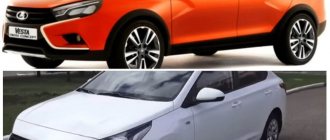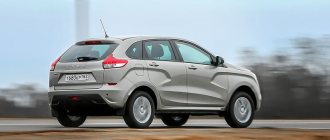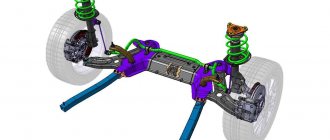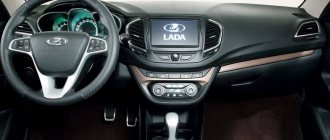Exterior
First, let's go over the appearance of the two Koreans.
Both cars have a tolerable design, however, the manufacturer Kia is positioning its model as a youth model, while Hyundai is for the older generation. But these frameworks are extremely arbitrary. The new Solaris has acquired a sharper frontal appearance. The headlights took on more square shapes and extended along the edges of the body. A huge air intake under the front bumper gave the car massiveness and solidity. From the side, the situation has practically not changed - the lines of the rear doors soaring upward, small windows and taillights - all this was present in the predecessor. There are also quite a few changes at the rear: the configuration of the rear bumper has changed and the reflectors have been transformed.
Kia Rio also has not undergone significant changes in terms of exterior. The front of the car was designed to give the car aggression and speed, which turned out quite well: the headlights acquired sharp angles and merged with the radiator grille, forming a semblance of a smile, a small air intake was located under the front bumper, and fog lights framed its edges.
It is impossible to identify a leader here. Both cars are designed with speed and style, but the way they implement this concept is different.
It's no secret that the KIA Rio and Hyundai Solaris are essentially twins, especially in technical terms. But if Hyundai is aimed at sedate buyers over the age of 30, then Rio was created with an eye on the youth audience. This determined its design, made in the style of “flowing lines”.
It's hard to resist such a car!
The profile of the car is slightly inclined forward, there are spectacular stampings along the side panels, the chrome of the window opening adds ambiance, the roof is slightly tilted back, and the rear, with its large lights, is very harmonious. All this merges into a modern and fresh image that attracts young people so much.
Harmony in the image - it is not surprising that many choose Rio.
Lada Vesta, however, is in no way inferior. But in it, sophistication is replaced by aggressiveness. Classically shaped headlights, an air intake and a radiator grille, combined together with the curve of the chrome lines, create the image of a modern sedan. Moreover, this appearance will suit any buyer, regardless of age.
A powerful front end is Vesta’s trump card!
The profile is no less impressive. You just have to look at the X-shaped lines of the panels and the rims to immediately fall in love with this car. But the stern didn’t disappoint either – the straight lines of the lights look great against the background of the chrome-plated LADA letters.
But the profile of the Lada is no worse.
Interior
The interior of the cars is made in accordance with the manufacturers' statements about their character.
The Solaris salon has classic features, diluted with signs of modern technology. The stylish design determines the placement of elements on the dashboard: the symmetrically located tachometer and speedometer, illuminated by blue backlight, look elegant and attractive. However, there is an inconvenience that manifests itself in recessed door handles, which look ascetic against the background of everything else.
When looking at the interior of the Rio, one recognizes the strict notes of a sports car. The backlight is white, and the speedometer takes up significant space on the instrument panel. The advantage of the Rio at this point will be the leather-covered visor, where the Solaris has hard plastic in this place.
The interior of the two cars is well designed, with the only difference being that the Solaris console takes on a drop-shaped appearance, while the Rio console takes on an angular appearance. There are also no significant differences in ergonomics: the arrangement of elements in each car is logical and distributed in such a way as to ensure maximum comfortable operation.
But when you look inside the cars, you can see, if not outright plagiarism, then very similar motives in the interior design. It is noticeable that AvtoVAZ designers were impressed by the inner world of the Korean model.
The dashboard, center console, 3-spoke steering wheel are all pretty similar. Of course, one cannot deny Vesta’s interior originality and originality, but there are certainly similarities. On the other hand, both models are ok with ergonomics, and there are no complaints about visibility either. The finishing materials are of sufficient quality, as for class B.
But the interior of the Lada Vesta is no worse.
Luggage racks
Lada Vesta
Hyundai Solaris
Kia Rio
Volkswagen Polo
The Lada compartment boasts almost smooth walls and the largest volume (data from our “ball” measurements in the table below). Rio is close to Lada, Polo is in the middle in terms of spaciousness, but pleases with the lowest loading height. But the new Solaris is an outsider: both in terms of trunk volume and opening size.
All have semi-padded lids and convenient handles for closing. And the hinges, which threaten to damage bulky luggage, seem to be made in the same factory. But Vesta’s trunk is unlocked with an archaic key, even in the top version, and the hefty springs that lift the lid are in plain sight. In Polo they are covered with upholstery, and the “Koreans” boast of neat torsion bars.
For transporting long items, it is more convenient than other Volkswagens: the folding backrests open up the largest opening, and only the Polo has split, folding and easily removable rear seat cushions.
| Luggage compartment volume, l | ||
| Automobile | Measurement technique | |
| Autoreview | VDA/SAE | |
| Lada Vesta | 620 | —/480 |
| Hyundai Solaris | 540 | 480/— |
| Kia Rio | 606 | 500/— |
| Volkswagen Polo | 577 | 460/— |
Options and cost
Both LADA Vesta and KIA Rio provide their customers with an abundance of trim levels - 6 for the Russian sedan and 7 for the Korean one. In general, Lada offers richer or similar equipment, and at a significantly lower price, which is especially noticeable in the basic trim levels. So, the price for Kia Rio starts from 601,900 rubles. and for Vesta - from 514,000 rubles. The difference is 87,900 rubles. very significant for this class.
Photo of KIA Rio in basic configuration.
In addition, top-end configurations for the 1.4-liter version of Rio are not offered at all, because they are intended only for 123-horsepower modifications. The maximum price for KIA Rio is RUB 871,900. And LADA Vesta – 658,000 rubles. That is, the difference grows to 213,900 rubles. For such a segment, this is an extraordinary reason to think!
The top LADA Vesta is noticeably cheaper!
LADA VESTA
| Equipment | Specifications | Price, rub.) |
| Classic | 1.6 l 16 cl. (106 hp), 5MT | 584 900 |
| Classic/Start | 1.6 l 16 cl. (106 hp), 5MT | 609 900 |
| Classic/Start | 1.6 l 16 cl. (106 hp), 5AMT | 634 900 |
| Comfort | 1.6 l 16 cl. (106 hp), 5MT | 637 900 |
| Comfort/Image | 1.6 l 16 cl. (106 hp), 5MT | 660 900 |
| Comfort | 1.6 l 16 cl. (106 hp), 5AMT | 662 900 |
| Comfort / Multimedia | 1.6 l 16 cl. (106 hp), 5MT | 665 900 |
| Comfort | 1.8 l 16 cl. (122 hp), 5MT | 672 900 |
| Comfort/Image | 1.6 l 16 cl. (106 hp), 5AMT | 685 900 |
| Comfort / Multimedia | 1.6 l 16 cl. (106 hp), 5AMT | 690 900 |
| Comfort/Image | 1.8 l 16 cl. (122 hp), 5MT | 695 900 |
| Comfort | 1.8 l 16 cl. (122 hp), 5AMT | 697 900 |
| Luxe | 1.6 l 16 cl. (106 hp), 5MT | 700 900 |
| Comfort/Image | 1.8 l 16 cl. (122 hp), 5AMT | 720 900 |
| Luxe | 1.6 l 16 cl. (106 hp), 5AMT | 725 900 |
| Luxe / Multimedia | 1.6 l 16 cl. (106 hp), 5MT | 728 900 |
| Luxe | 1.8 l 16 cl. (122 hp), 5MT | 735 900 |
| Luxe / Prestige | 1.6 l 16 cl. (106 hp), 5MT | 746 900 |
| Luxe / Multimedia | 1.6 l 16 cl. (106 hp), 5AMT | 753 900 |
| Luxe / Multimedia | 1.8 l 16 cl. (122 hp), 5MT | 763 900 |
| Luxe / Prestige | 1.8 l 16 cl. (122 hp), 5MT | 781 900 |
| Luxe / Multimedia | 1.8 l 16 cl. (122 hp), 5AMT | 788 900 |
| Luxe / Prestige | 1.8 l 16 cl. (122 hp), 5AMT | 806 900 |
| Exclusive | 1.8 l 16 cl. (122 hp), 5MT | 814 400 |
| Exclusive | 1.8 l 16 cl. (122 hp), 5AMT | 839 400 |
More on the topic: Kia Rio 2021 or Hyundai Solaris 2021: comparison, which is better
Current configurations and prices for Lada Vesta are available at LINK
KIA RIO
| Equipment | Specifications | Price, rub.) |
| Classic H0S4K4617 | 1.4 l 100 l. With. 6MT | 709 900 |
| Classic Audio H0S4K4617 | 1.4 l 100 l. With. 6MT | 744 900 |
| Comfort H0S4K4617 | 1.4 l 100 l. With. 6MT | 769 900 |
| Comfort H0S4K461F | 1.4 l 100 l. With. 6AT | 809 900 |
| Comfort H0S4D2617 | 1.6 l 123 l. With. 6MT | 794 900 |
| Comfort H0S4D261F | 1.6 l 123 l. With. 6AT | 834 900 |
| Luxe H0S4D2617 | 1.6 l 123 l. With. 6MT | 819 900 |
| Luxe H0S4D261F | 1.6 l 123 l. With. 6AT | 859 900 |
| Prestige H0S4D2617 | 1.6 l 123 l. With. 6MT | 919 900 |
| Prestige H0S4D261F | 1.6 l 123 l. With. 6AT | 959 900 |
| Premium H0S4D261F | 1.6 l 123 l. With. 6AT | 1 019 900 |
Current configurations and prices for KIA Rio are available at LINK
As you can see, a comparison of the Kia Rio and Lada Vesta clearly shows that the significant difference in cost is due, first of all, to a more powerful engine, a 6-speed automatic transmission and finishing elements. Indeed, in terms of equipment, the models are approximately equal, and the advantage of Rio in the number of airbags is offset by the large number of electronic systems in Vesta.
The basic equipment includes power windows, heated windows and audio preparation, that is, everything that should be in a modern car.
Climatic comfort
Warm up for 14 minutes when driving at a constant speed of 60 km/h (overboard - two degrees below zero). With the temperature controls turned up to maximum, the climate controls of Lada, Volkswagen and Kia operated in fully automatic mode, and the Hyundai “manual” system was set to distribute flows “to the glass and to the feet”, the fan speed was the second.
If in Kia only the upper part of the rim is well heated, then in Hyundai the entire steering wheel is heated. True, a warm steering wheel is available to Solaris starting with the “medium” version of Comfort, and for Rio 1.6 it is already “in the base”. Polo and Vesta steering wheel heating is not yet available
More on the topic: How to change the oil in a Hyundai Solaris manual transmission
Specifications
The differences are small, but they naturally exist. It’s worth following them, but it’s better to do a test drive before buying – the difference in technical characteristics of one model from another seems too insignificant. This means that sensations matter.
| Kia Rio | Hyundai Solaris | |
| Engine |
|
|
| Consumption |
|
|
| Suspension |
|
|
| Dynamics | Acceleration 0-100 km/h: 11.5 s. Maximum speed: 190 km/h | Acceleration 0-100 km/h: 11.5 s. Maximum speed: 190 km/h |
| Brakes |
|
|
| Dimensions |
|
|
| Where is it produced? | Russia, near St. Petersburg | Russia, near St. Petersburg |
| Safety |
|
|
| Other |
|
|
More on the topic: Comparison of Kia Rio and Hyundai Solaris
Engine
It makes no sense to compare the power units of two foreign cars - they are the same. The cars are equipped with two engine options: 1.4 liters with a power of 107 hp. With. and 1.6 l 123 l. With. The dynamics provided by these engines are quite sufficient for city cars, however, the Rio clearly lacks the agility inherent in youth cars.
With the gearbox, everything is also quite clear: 2 manual transmission options with 5 and 6 stages and 2 automatic transmissions with 4 and 6 ranges.
It should be said about the six-speed manual transmission, which is installed on 123-horsepower engines. One of the gears is redundant, a weak engine will not allow you to feel the drive from driving or better feedback, so increasing the cost for a 6-speed manual transmission is a waste.
Both Koreans have hydraulic power steering systems and disc brakes. The chassis has an independent front axle and MacPherson struts.
On the road, the sedans are similar in many ways, but the Kia seems sharper and more collected, unlike its Korean counterpart. Hyundai is calmer and softer, which is what a reputable car should have.
What's the result?
And now - a little pure gag. Did you notice that in the text I never went into compliments, did not use the expressions “for the first time in a Russian car,” and so on? Because enough drool and snot. It's time to treat AVTOVAZ like a normal automaker. Accordingly, demand from him that the products are at least at the level of competitors.
Kia Rio is one of the leaders not only in the segment, but also in the Russian car market as a whole. On its side is a neat interior, a pleasant, although not the brightest, design, and an already well-established image of a reliable, durable car. I am personally ready to answer for each of these statements. Hyundai Solaris is exactly the same, only different, with blue backlighting. Personally, I don't like it only in terms of design. Well, what is there: this blue color in the cabin infuriates me!
Lada Vesta is a promising contender that can take away a significant share of buyers from the leaders. Thank God that the suspension is smartly tuned for bad roads - in our country there are many more of them than high-speed serpentines. What can I say, there is almost no place to implement good handling in Russia, and potholes are now found even on the central streets of cities with a population of over a million, not to mention the outback.
I would (I didn’t expect it myself) choose the Russian new product. Not for patriotic reasons. I just like her better, without any reservations. The only thing that can prevent Vesta from becoming a bestseller is the high price. I want to believe that Bo Andersson understands this. And before the price list is announced, I'm keeping my fingers crossed.
https://www.youtube.com/watch?v=MTh4iJWwY_Y
It is difficult to give preference in choosing two twin brothers, which are Rio and Solaris. Both cars have similar disadvantages and advantages, and their purchase and technical support costs differ slightly. Apparently, if you are thinking about buying one of these foreign cars and cannot decide which is better, then you should choose based on your preferences in appearance and interior design.
More about Solaris
- What is better Hyundai Solaris or Audi A4
- Let's choose the best car between Kia Rio and Hyundai Solaris
- Which is better Hyundai Solaris or Hyundai Sonata
- Choice: Hyundai Solaris 2011 or Ford Mondeo IV 2010?
- Which is better Lada Vesta or Hyundai Solaris, reviews
- Comparison of Lada Vesta and Hyundai Solaris
- Comparison of Kia Rio and Hyundai Solaris hatchbacks
- Which is better: Kia Rio or Hyundai Solaris
- Nissan Almera or Hyundai Solaris - which is better: comparison of cars
- Comparison of Renault Logan and Hyundai Solaris
Markups or discounts?
Hyundai Solaris did not cause such a stir as the Creta: two weeks after the start of sales, cars with automatic transmissions are in stock at almost all dealers. But you will have to hunt for “mechanics” and inexpensive trim levels.
The problem is that most Hyundai dealers, sensing a taste of easy money from the example of the Creta, immediately put alarms, engine compartment protection and other “extras” on Solaris. The average size of such a markup is 50 thousand rubles, but the amount sometimes reaches 100 thousand. At the same time, there are no discounts on the new Solaris and are not expected in the near future. So there is only one way to buy a Hyundai profitably - put pressure on the manager and refuse the “extras” under any pretext.
Buy Rio, Polo or Vesta? No problem! The seller will also increase the price.
Kia has a centralized discount on the most popular versions of Rio (it is declared by the representative office) of 20 thousand rubles, on less popular ones - 40 thousand. The dealer himself is ready to throw off a maximum of another ten thousand rubles or make a nice gift within this amount.
In Volkswagen and Lada they bargain more willingly - with some persistence you can get a concession of 60 thousand rubles.
In other words, for a real buyer with 700 thousand in his pocket, any Lada is available, but Kia and Volkswagen for this money can offer either a “mechanics” in the middle configuration, or an “automatic”, but almost naked. And Hyundai only has a small 1.4 engine, a “handle” and a living wage for the Active Plus version. And then if you are lucky enough to find such a Solaris without dealer extras.
What else can you get for 700 thousand rubles?
I would immediately dismiss the Chinese fraternity due to the incomprehensible situation with reliability, availability of spare parts and low resale price on the secondary market.
Ford Fiesta? It is even tighter than the Rio, the trunk is modest, and even taking into account large dealer concessions (up to 70 thousand rubles!) and discounts for the 2016 release of the Fiesta 1.6 Trend with a “robot” it will barely fit into the 700 thousand budget.
Renault Logan? In the case of Logan, dealers of the French brand are reluctant to bargain; in Moscow you can extract a maximum of 30 thousand rubles from them from the price list. That is, our budget includes a metallic-painted Logan 1.6 (102 hp) in a fairly rich Privilege package with a safety package (ESP, side airbags, parking sensors). But the Logan is rustic to drive, uncomfortable and noisy inside, and the main problem is the ancient and unreliable four-speed DP2 automatic transmission.
Ravon R4
There is also the Ravon R4, that is, the Chevrolet Cobalt renamed in Uzbekistan (the first cars began to arrive at Moscow dealers after we completed this test), which was quite good to drive, had a strong suspension, was spacious and reliable. We also liked the combination of a playful one and a half liter engine (106 hp) and a six-speed automatic transmission.
And all this with air conditioning for only 600 thousand rubles - come and get it! True, the R4 does not have a stabilization system in any of the trim levels. And don't rely on dealer discounts. Because in the next few months you can expect an increase in price, as was the case with the Nexia R3 after the start of sales last year.
More on the topic: Which is better: Kia Rio or Hyundai Solaris
* Excluding discounts for trade-in, disposal and purchase on credit











